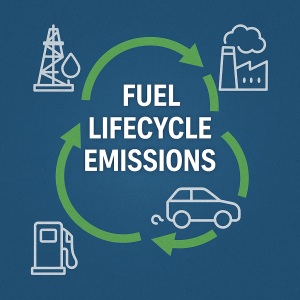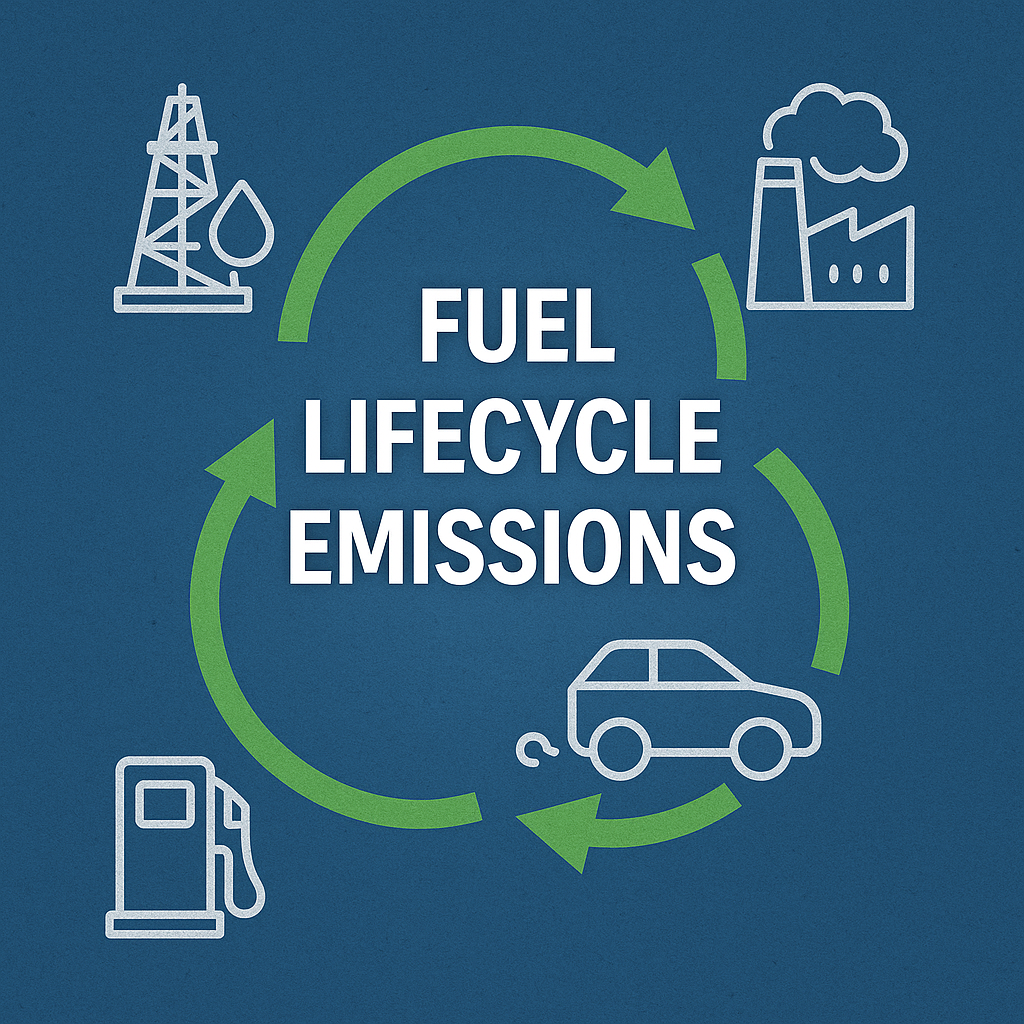Explore lifecycle emissions of biofuels and e-fuels in shipping. Learn about indirect impacts, real-world case studies, challenges, and future trends.
 The maritime industry is navigating one of its greatest transitions: the shift from fossil-based fuels to low-carbon and renewable alternatives. Biofuels and e-fuels (synthetic fuels produced using renewable electricity, CO₂, and water) are frequently highlighted as promising solutions. They offer the potential to reduce greenhouse gas (GHG) emissions and align shipping with International Maritime Organization (IMO) 2050 climate goals.
The maritime industry is navigating one of its greatest transitions: the shift from fossil-based fuels to low-carbon and renewable alternatives. Biofuels and e-fuels (synthetic fuels produced using renewable electricity, CO₂, and water) are frequently highlighted as promising solutions. They offer the potential to reduce greenhouse gas (GHG) emissions and align shipping with International Maritime Organization (IMO) 2050 climate goals.
But the reality is more complex. Evaluating fuels solely at the point of combustion — the exhaust from the funnel — does not capture their true environmental footprint. To fully understand sustainability, we must adopt a lifecycle approach: considering emissions from feedstock cultivation, fuel production, transport, storage, and end use.
This is particularly critical for biofuels and e-fuels. While they are marketed as “carbon neutral” or “renewable,” both carry indirect impacts — such as land use changes for biofuels or high electricity demand for e-fuels. For shipowners, policymakers, and researchers, accounting for these indirect emissions is essential to avoid greenwashing and to identify genuine pathways to decarbonization.
This article provides a comprehensive, SEO-optimized analysis of the lifecycle emissions of biofuels and e-fuels, their challenges, innovations, case studies, and future role in maritime operations.
Why This Topic Matters in Maritime Operations
Shipping accounts for about 3% of global GHG emissions, equivalent to nearly 1 billion tonnes of CO₂ annually. With global trade projected to grow, these emissions could rise significantly unless new fuels and efficiency measures are adopted.
The IMO has committed to:
-
Reduce carbon intensity by at least 40% by 2030 (vs. 2008 levels).
-
Reach net-zero GHG emissions “by or around 2050.”
Meeting these targets requires the adoption of alternative fuels. However, unless lifecycle emissions are factored in, the industry risks adopting fuels that appear clean at the exhaust pipe but cause major emissions upstream.
For instance:
-
A biofuel derived from palm oil may reduce emissions onboard but drive deforestation in Southeast Asia, releasing massive amounts of stored carbon.
-
An e-fuel produced with electricity from coal-fired power plants may have a higher carbon footprint than traditional marine diesel.
For shipowners, charterers, and regulators, understanding these indirect impacts is essential for long-term compliance, reputational credibility, and genuine climate mitigation.
Key Developments, Innovations, or Technologies
Lifecycle Assessment (LCA) Methodologies
Lifecycle Assessment (LCA) is the standard method used to evaluate a fuel’s total carbon footprint, from production to consumption. Organizations such as the International Council on Clean Transportation (ICCT) and DNV have developed models that compare different fuel pathways for shipping.
Two common boundaries are applied:
-
Tank-to-Wake (TTW): Emissions measured only when the fuel is burned onboard.
-
Well-to-Wake (WTW): Includes upstream processes such as raw material extraction, processing, refining, and transport.
For meaningful decarbonization, IMO and the EU now emphasize Well-to-Wake accounting.
Biofuels
Biofuels are produced from organic materials such as vegetable oils, agricultural residues, and waste.
-
First-generation biofuels: Made from food crops (e.g., corn, sugarcane, palm oil).
-
Second-generation biofuels: Derived from waste biomass or non-food feedstocks.
-
Advanced biofuels: Include algal fuels and lignocellulosic biomass.
Lifecycle Impacts:
-
Emissions vary widely depending on feedstock. Waste-based biofuels may reduce GHGs by 60–90%, while palm oil-based biofuels may result in higher emissions than fossil fuels due to land use changes.
-
Fertilizer use, harvesting machinery, and land clearing contribute significantly to indirect emissions.
E-fuels (Synthetic Fuels)
E-fuels, also called electrofuels or power-to-X fuels, are made by combining renewable hydrogen (produced via electrolysis using renewable electricity) with captured CO₂ to produce liquid fuels such as e-methanol, e-diesel, or e-kerosene.
Lifecycle Impacts:
-
If powered by 100% renewable electricity and CO₂ captured from the air, e-fuels can be near-zero-carbon fuels.
-
However, if grid electricity is fossil-heavy, e-fuels can have higher lifecycle emissions than HFO.
-
Energy intensity is a challenge: producing one ton of e-methanol requires about 10–15 MWh of electricity.
Regulatory Momentum
-
EU FuelEU Maritime (2023): Requires shipping companies to gradually reduce GHG intensity of energy used onboard, based on Well-to-Wake calculations.
-
IMO Guidelines (2023): Increasing focus on lifecycle emission factors, supported by classification societies such as Lloyd’s Register, ABS, and DNV.
-
ISO Standards: Work is underway to standardize LCA for shipping fuels globally.
Challenges and Practical Solutions
1. Feedstock Availability for Biofuels
-
Challenge: Limited waste and residue availability may not scale for global shipping needs. Heavy reliance on food-based biofuels risks deforestation, food price inflation, and land use conflicts.
-
Solution: Prioritize second- and third-generation biofuels (e.g., from waste oils, algae, agricultural residues). Certification schemes (e.g., ISCC) ensure sustainability.
2. High Energy Demand for E-fuels
-
Challenge: E-fuels require massive renewable electricity capacity. Global production is currently negligible compared to projected demand.
-
Solution: Invest in dedicated renewable plants near ports, and integrate carbon capture technologies. Early deployment in green corridors can build experience.
3. Cost Competitiveness
-
Challenge: Biofuels and e-fuels are currently 2–5 times more expensive than marine diesel. Without financial incentives, adoption is limited.
-
Solution: Implement carbon pricing mechanisms (EU ETS, IMO carbon levy), subsidies, and contracts for difference to close the price gap.
4. Safety and Handling
-
Challenge: E-fuels like e-methanol are toxic, and hydrogen-based fuels require cryogenic storage. Biofuels can cause engine deposit issues if not standardized.
-
Solution: Develop IMO-aligned bunkering and handling guidelines, supported by classification societies and port authorities.
Case Studies / Real-World Applications
Biofuels in European Shipping
-
Maersk, CMA CGM, and Hapag-Lloyd have conducted successful voyages using biofuel blends of up to 30%.
-
Trials with waste cooking oil-derived biodiesel showed reductions of up to 85% in lifecycle CO₂ emissions.
-
However, sustainability varies. A European Commission report (2022) found that palm oil biodiesel could emit three times more CO₂ than fossil diesel when indirect land use change is included.
E-fuels Demonstrations
-
Maersk’s e-methanol container ship (2023): The first large ocean-going vessel to run on e-methanol, highlighting scalability challenges but also proving viability.
-
Synhelion’s solar-to-fuel demonstration (Switzerland, 2023): Produced synthetic kerosene directly from sunlight, water, and CO₂, showing how renewable electricity can close the carbon loop.
-
Japan’s e-fuel consortia: Companies like MOL and NYK are investing in large-scale pilot plants to produce ammonia and e-methanol.
Future Outlook & Trends
-
Short Term (2023–2030): Biofuels serve as a bridge, especially waste-based types. E-fuel pilots scale up but remain costly. Regulations like EU ETS and FuelEU Maritime accelerate adoption.
-
Medium Term (2030–2040): Industrial-scale e-fuel plants begin supplying shipping corridors. Certification standards harmonize global sustainability metrics.
-
Long Term (2040–2050): E-fuels dominate deep-sea shipping, while biofuels remain niche for regional and smaller vessels. IMO’s 2050 net-zero goals hinge on large-scale renewable electricity deployment.
The likely scenario is a multi-fuel future, where biofuels, e-fuels, hydrogen, ammonia, and methanol coexist depending on vessel type, trade route, and regional policy.
Frequently Asked Questions (FAQ)
1. What are lifecycle emissions?
They are the total emissions associated with a fuel, from production and distribution to onboard combustion.
2. Why are biofuels not always sustainable?
Feedstocks like palm oil can cause deforestation, releasing more carbon than fossil fuels save.
3. Are e-fuels really carbon neutral?
Yes, if produced using renewable electricity and captured CO₂. If fossil-based power is used, they may be more polluting than HFO.
4. Which is cheaper: biofuels or e-fuels?
Biofuels are generally cheaper today but limited in scale. E-fuels are more expensive but more scalable long term.
5. Can ships use biofuels and e-fuels now?
Yes. Biofuels are already drop-in compatible. E-fuels like e-methanol require dual-fuel engines, which are entering service.
6. How is the IMO addressing lifecycle emissions?
By shifting regulations to Well-to-Wake accounting, supported by classification societies and regional policies.
7. Will one fuel dominate by 2050?
Unlikely. A combination of fuels will be used, with e-fuels playing the largest role in deep-sea shipping.
Conclusion
Fuel lifecycle emissions matter because they tell the full story of a fuel’s climate impact. Biofuels and e-fuels hold promise, but their indirect effects — from deforestation to electricity demand — must be accounted for if shipping is to meet IMO’s net-zero goals.
Biofuels provide an immediate, low-barrier entry into decarbonization, but sustainability depends on feedstock choices. E-fuels represent a long-term, scalable pathway, but require enormous renewable energy investments.
The future of shipping will not hinge on a single solution. Instead, it will depend on a portfolio of fuels, technologies, and efficiency measures, underpinned by robust Well-to-Wake lifecycle accounting. For the industry, the challenge is clear: decarbonize not just at sea, but across the entire supply chain.
References
-
International Maritime Organization (IMO). (2023). IMO Strategy on Reduction of GHG Emissions from Ships.
-
DNV. (2023). Maritime Forecast to 2050: Fuel Pathways and Lifecycle Analysis.
-
Lloyd’s Register. (2023). Fuel Readiness Level and Lifecycle Emissions.
-
European Commission (DG MOVE). (2022). FuelEU Maritime Regulation and Sustainability of Biofuels.
-
UNCTAD. (2022). Review of Maritime Transport.
-
S&P Global Commodity Insights. (2023). Synthetic Fuel Cost Projections.
-
ICCT. (2022). Lifecycle Emissions of Marine Fuels.
-
Marine Pollution Bulletin. (2022). Indirect Land Use Change and Biofuels in Shipping.
-
Wärtsilä. (2022). E-fuels and the Future of Marine Energy.
-
The Maritime Executive. (2023). “Maersk Launches First Methanol-Fueled Container Ship.”
-
Synhelion AG. (2023). Solar Fuels Demonstration on Lake Lucerne.

